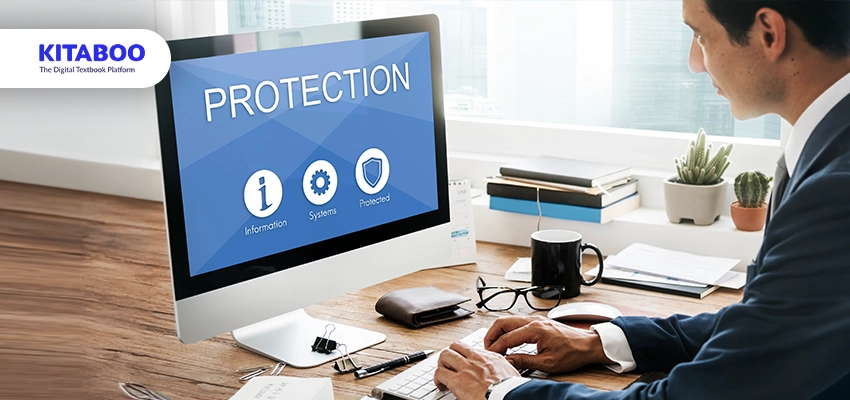
How to Protect Your Work with Copyright for eBooks
Summarize this blog with your favorite AI:
With the growing popularity of online resources, publishers and authors have to safeguard their work using suitable legal procedures. Without appropriate protections, your hard work could be copied, altered, or shared without your permission.
Copyright provides you control over how your digital materials are used and safeguard your artistic work. Protecting your intellectual property and income requires a knowledge of and application for eBook copyright rights.
This article will explore ways to secure copyright for eBooks and technologies to improve content security.
Table of Contents
I. What Is Copyright for eBooks?
II. Why Copyright Digital Content?
- The Increasing Risk of Digital Piracy
- Ensuring Author and Publisher Rights
- Tools to Enhance Security
III. Securing Copyright for eBooks
- Understand the Copyright Process
- Incorporate Digital Rights Management (DRM)
- Use Copyright Notices
- Watermark Your Content
- Publish Through Secure Platforms
IV. Addressing eBook Copyright Infringement
V. Conclusion
What Is Copyright for eBooks?
eBook copyright is a legal framework that grants writers and publishers exclusive rights. Among these rights are those regarding reproduction, distribution, adaptation, public performance, and exhibition of the work. Digital versions of books are more prone to illegal sharing or piracy; hence, copyright protection becomes even more crucial.
Copyright is automatically given when creating your work; however, registering your eBook copyright with the appropriate authorities strengthens your claim. A registered copyright gives verified proof of ownership and allows for legal action if eBook copyright infringement occurs. Beyond protection, copyright rules set clear bounds for fair use, ensuring that your work is appreciated and properly attributed.
Why Copyright Digital Content?
The digital revolution has made material more accessible than ever, but it also presents new obstacles. Authors and publishers confront considerable dangers, including piracy and unauthorized distribution, which makes it critical to prioritize digital material copyright protection.
The Increasing Risk of Digital Piracy
The digital publishing sector has increased content accessibility, but it has also generated new issues such as piracy and plagiarism. A single pirated copy can be circulated on multiple platforms, resulting in considerable revenue losses for authors and publishers. Protecting their content is no longer an option for those who sell eBook publication rights; it is a need.
Ensuring Author and Publisher Rights
Tools to Enhance Security
Digital textbook platforms like KITABOO combine user-friendly access with sophisticated restrictions, including Digital Rights Management (DRM) and watermarking, to ensure that publisher content is accessed securely.
Securing Copyright for eBooks
To ensure that your work is completely safeguarded, you must use a combination of legal, technical, and strategic safeguards. These methods will help you protect your intellectual property and retain control of your eBook publishing rights.
Understand the Copyright Process
Copyright laws vary by country, but most offer automatic protection upon creation. While this fundamental degree of protection exists, registering your eBook copyright offers further benefits:
- Legal documentation of ownership
- The capacity to seek statutory damages in the event of infringement
- More credibility for authors and publishers
Visit the official copyright office of your country and submit the appropriate application to register your copyright. A formal copyright certificate is especially useful in legal conflicts involving eBook copyright infringement.
Incorporate Digital Rights Management (DRM)
DRM technologies guard your eBooks against illegal distribution, copying, or access. DRM content enforces permissions like these:
- Limiting the number of devices from which an eBook can be accessed
- Keeping people from copying or printing the content
- Controlling the expiration dates of temporary licenses
Platforms like KITABOO make DRM integration easier, allowing authors and publishers to secure their intellectual property without compromising user experience. This digital textbook platform ensures that only authorized users can access your information.
Use Copyright Notices
Including a copyright notice in your eBooks alerts users to your ownership and legal rights. A typical copyright notice contains:
- The copyright symbol (©)
- The year of publication
- The name of the copyright owner
For example: “© 2025 [Author Name]. All rights reserved.” This disclaimer indicates that the content is protected by copyright law, prohibiting abuse.
Watermark Your Content
Watermarks give an extra layer of security by putting visible or invisible identifiers in digital files. They discourage piracy and let writers monitor illegal use. Personalized watermarks help publishers ensure the traceability of every distributed file.
Publish Through Secure Platforms
Choose a publishing platform that prioritizes digital content copyright protection. Platforms like KITABOO offer secure distribution methods, making them perfect for educational publishers and independent authors. Their DRM and watermarking technologies improve security while preserving accessibility.
Addressing eBook Copyright Infringement
Copyright infringement is still possible even with your best efforts to safeguard your eBooks. Protecting your eBook publication rights and minimizing any losses depends on the identification and fast response to illegal use of your work.
Identifying Infringement
Detecting eBook copyright infringement requires vigilance. Common methods include:
- Reverse Image Searches: Use tools like Google Reverse Image Search to discover unauthorized use of book covers.
- Piracy Monitoring Services: Tools like Blasty and DMCA Protection scan the internet for unlawful copies of your eBooks.
- User Analytics: Publishing platforms offer analytics that can help discover odd access patterns, indicating potential misuse.
Taking Action Against Infringement
If your eBook publishing rights are violated:
- Document Evidence: Take screenshots or download unauthorized copies for proof.
- Send a Cease-and-Desist Letter: Inform the infringer about your copyright and demand that they stop utilizing your work.
- File a DMCA Takedown Notice: Send a request to the hosting platform or search engine to remove the infringing content.
- Consider Legal Action: For serious violations, consult a copyright attorney about filing a lawsuit.
Conclusion
Maintaining your intellectual property, earning revenue, and keeping your reputation depend on you securing copyright for eBooks. DRM, copyright protection, and watermarking are among the techniques authors and publishers might use to properly protect their work. Using reliable digital textbook platforms like KITABOO improves the security of your work and enables smooth distribution.
Advanced features from KITABOO, including watermarking, DRM integration, and analytics, help to ensure your eBook publishing rights. Schedule a demo today to find out how you can protect your digital content.
Also Check:
Discover how a mobile-first training platform can help your organization.
KITABOO is a cloud-based platform to create, deliver & track mobile-first interactive training content.


![Top 5 Free Publishing Sites for Independent Publishing [2026]](https://kitaboo.com/wp-content/uploads/2025/09/Top-5-Free-Publishing-Sites-for-Independent-Publishing-2026-420x235.webp)
